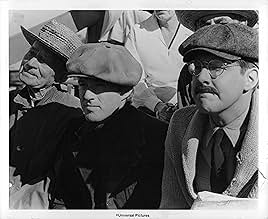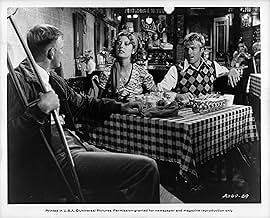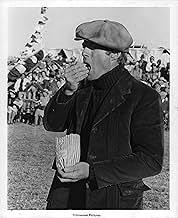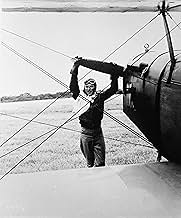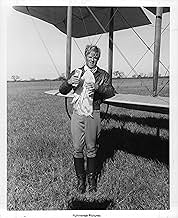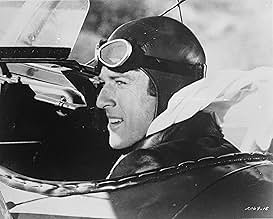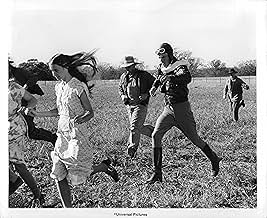Après la Première Guerre mondiale, un ancien pilote rencontre par hasard un ancien pilote de chasse allemand avec lequel il fera des films hollywoodiens illustrant des combats aériens.Après la Première Guerre mondiale, un ancien pilote rencontre par hasard un ancien pilote de chasse allemand avec lequel il fera des films hollywoodiens illustrant des combats aériens.Après la Première Guerre mondiale, un ancien pilote rencontre par hasard un ancien pilote de chasse allemand avec lequel il fera des films hollywoodiens illustrant des combats aériens.
- Farmer
- (as James Harrell)
Histoire
Le saviez-vous
- AnecdotesThere are no studio takes in airplanes. All close-ups of actors being airborne were done for real, sometimes with George Roy Hill, a former Marine pilot himself, flying the airplane while directing. Scenes with Robert Redford and Bo Svenson climbing out on the wing were done without any security harness or parachutes.
- GaffesWhen Ezra and Waldo drive up to the farmhouse in Ezra's pick-up it is very obvious that the truck looks far too old for the 1920's time frame of the movie. In the late 1920's that truck would have been new or nearly new. Instead, it is obviously 40 or 50 years old (which is just about exactly the age it would have been when the movie was released in 1975).
- Citations
Dillhoefer: Now, here's what we do. We put her up on the wing...
Duke: And she'll fake being afraid...
Dillhoefer: Right.
Duke: And the wind will blow her clothes off!
Dillhoefer: Yes! Yes!
Waldo Pepper: Wait! Why would the wind blow her clothes off? When I'm wing-walking, the wind doesn't blow MY clothes off.
Dillhoefer: Fool! Nobody wants to come and see YOU with YOUR clothes off!
- ConnexionsFeatured in Hooper (1978)
The casting is excellent - not a single actor is unfit for the part. Redford's looks and charisma, coupled with the fact that while he is still pretty young he does have a few visible age lines, make him perfect for the part of a debonair flyboy, ten years removed from World War I, who is stubbornly resisting the increasing regulation of flying as a profession. Bo Svensen is a great complement as the slightly older, more experienced, and more even-keeled Axel Olsson. Geoffrey Lewis' Newt Potts, Pepper's old squadron commander, represents the future that Pepper is trying to avoid. Ed Herrmann is the embodiment of the "seat of your pants" spirit of the early aircraft producers. Phil Bruns is a convincing "carnival barker" as Doc Dillhoeffer. And the Swedish actor Bo Brundin puts in a great turn as Ernst Kessler, German fighter ace turned barnstormer, who has long since realized that the bravery and chivalry he found in the air (both among comrades and opponents) is rarely found on the ground.
Kessler is based on Ernst Udet, the second-highest scoring German ace of WWI. Udet barnstormed after the war, had a shortened version of "Lola" painted on his Fokker D-VII, and had a fight similar to the epic battle that is an important subplot in the movie. Thus it is a nice touch that Udet is shown in the opening photo montage. (It's also good that no sequel was made - I'd hate to see the Kessler character return to Germany, join Hitler's Luftwaffe and commit suicide.)
This is also notable, on a personal level, as the first place I ever saw Susan Sarandon. I've been a fan ever since. Hell, she still looks great.
The flying sequences are magnificent. There's no CGI here, folks. These are real aircraft - beautiful replicas of Curtiss Jennies, Standard E-4's, and of course the Sopwith Camel and Fokker Triplane (plus a few others) - doing real stunt flying. The talented stunt pilots are credited under the umbrella of Tallmantz Aviation, which I'm guessing was formed by legendary stunt pilots Frank Tallman and Paul Mantz. Tallman himself flew in this film (and died in a crash three years later; Mantz died making "Flight of the Phoenix," another of my favorite flight movies, in 1965.) And the climactic sequence, while it may seem unlikely to some, is actually based (perhaps loosely) on a similar incident that occurred during the filming of either "Hells' Angels" or "Wings" in the late 1920's. The only possible anachronism that I can spot is Kessler's stunt plane, which looks a little too advanced for 1928. But I could be wrong there.
Beautiful aircraft, great flying sequences, fine acting, and even a real plot - what more could you want?
- splat99
- 14 janv. 2004
- Lien permanent
Meilleurs choix
- How long is The Great Waldo Pepper?Propulsé par Alexa
Détails
Box-office
- Budget
- 5 000 000 $ US (estimation)
- Brut – États-Unis et Canada
- 20 642 922 $ US
- Brut – à l'échelle mondiale
- 20 642 922 $ US
- Durée1 heure 47 minutes
- Couleur
- Rapport de forme
- 2.35 : 1
Contribuer à cette page




